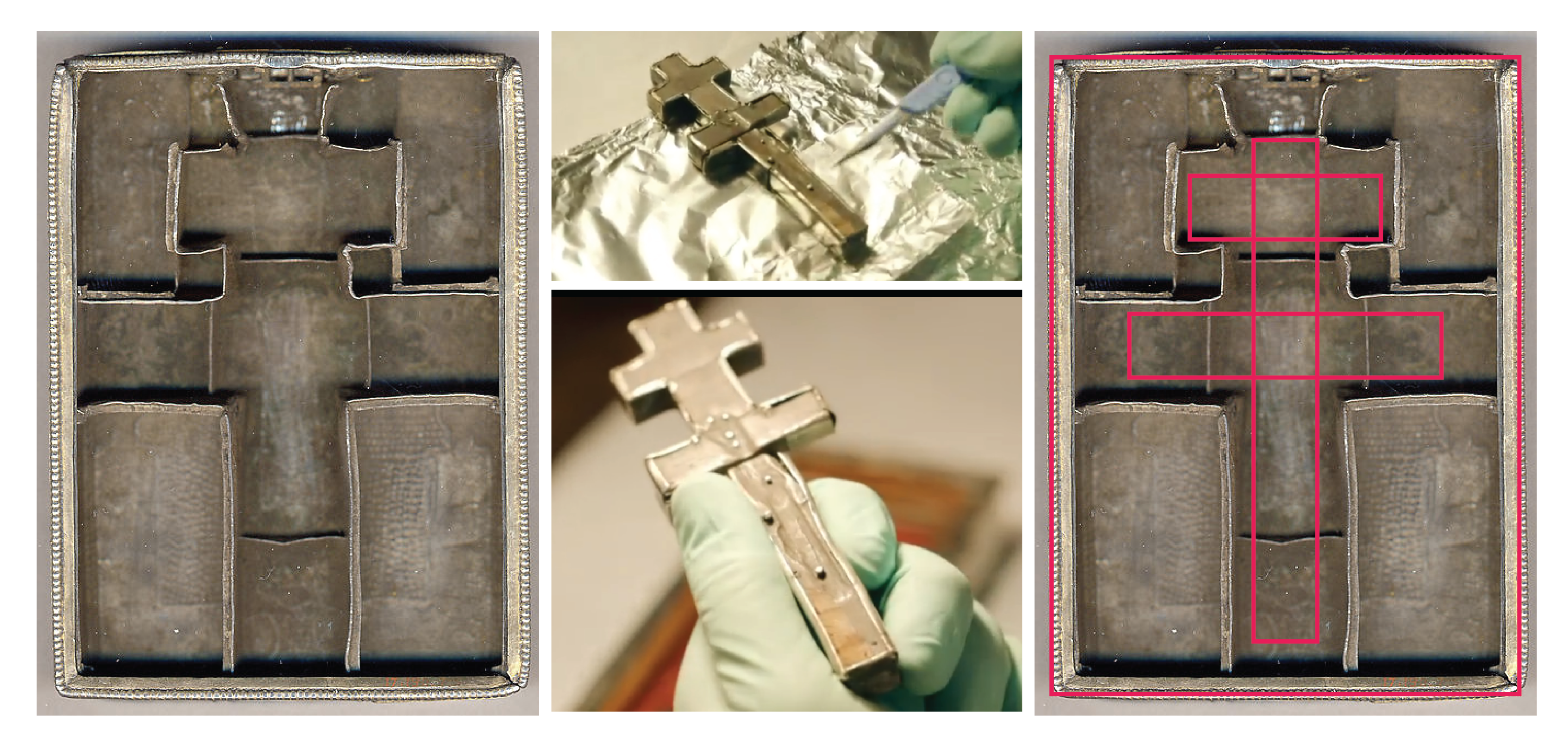|
Fieschi Morgan Staurotheke
The Fieschi Morgan Staurotheke is a small reliquary designed to hold a relic of the true cross, it is 1 1/16 x 4 1/16 x 2 13/16 inches (2.7 x 10.3 x 7.1 cm) overall with lid. It is an example of Byzantine enameling. The box is dated to 843 (some scholars speculate an earlier date of 815). Both dates hover around the second wave of Byzantine Iconoclasm from 814 to 842, allowing this piece to become a lens into the post iconoclastic art. These reliquaries doubled as an icon in style and purpose. The physical material of icons and the content within the reliquary were believed to contained a spirit or energy. It was believed that reliquaries contained great power, thus explains its preservation throughout the years. There are numerous theories of where this piece was created and its movement. It's currently on display at the Metropolitan Museum. Physical description The staurotheke is made from gilded silver, gold, enamel worked in cloisonné, and niello. The front lid depi ... [...More Info...] [...Related Items...] OR: [Wikipedia] [Google] [Baidu] |
Thomas The Apostle
Thomas the Apostle ( arc, 𐡀𐡌𐡅𐡕𐡌, hbo, תוֹמא הקדוש or תוֹמָא שליחא (''Toma HaKadosh'' "Thomas the Holy" or ''Toma Shlikha'' "Thomas the Messenger/Apostle" in Hebrew-Aramaic), syc, ܬܐܘܡܐ, , meaning "twin"; grc-x-koine, Θωμᾶς),; cop, ⲑⲱⲙⲁⲥ; mal, തോമാ ശ്ലീഹാ also known as (Greek: Δίδυμος ''Didymos,'' meaning "twin"), was one of the Twelve Apostles of Jesus according to the New Testament. Thomas is commonly known as "Doubting Thomas" because he initially doubted the resurrection of Jesus Christ when he was told of it (as is related in the Gospel of John); he later confessed his faith ("My Lord and my God") on seeing the Five Holy Wounds, wounds left over from the crucifixion. According to traditional accounts of the Saint Thomas Christians of modern-day Kerala in India, Saint Thomas travelled outside the Roman Empire to preach the Gospel, travelling as far as the Tamilakam which is in South ... [...More Info...] [...Related Items...] OR: [Wikipedia] [Google] [Baidu] |
Theodore Of Amasea
: ''For another Saint Theodore, see: Theodore Stratelates or Saint Theodore (other)''. Saint Theodore Tiron ( grc-gre, Ἅγιος Θεόδωρος Τήρων) is one of the two recognized saints called Theodore who are venerated as warrior saints and Great Martyrs in the Catholic Church, Oriental Orthodox Churches and Eastern Orthodox Churches. The other saint of the same name is Theodore Stratelates, also known as Theodore of Heraclea, but this second St Theodore may never have had a separate existence. When the epithet is omitted, the reference is usually to St Theodore Tiron. He is also known as Theodore Tyron ( grc-gre, ὁ Τήρων, variously romanized ''Tyro'' 'n'' ''Tiro'' 'n'' ''Teron''). ''Tīrō'' is a word from classical Latin meaning a "recently enlisted soldier or recruit". The Latin word was transliterated into Greek with various spellings (Τύρων, Τίρων, Τήρων or Τείρων). Life and martyrdom The veneration of St. Theodore is ... [...More Info...] [...Related Items...] OR: [Wikipedia] [Google] [Baidu] |
Saint Platon
Platon, born Paul Kulbusch (also spelled ''Kuhlbusch'' or ''Kuldbush''; – 14 January 1919) was an Estonians, Estonian bishop and the first Eastern Orthodox Church, Orthodox saint of Estonian ethnicity."Platon, Bishop of Estonia" ''Estonica - Encyclopedia about Estonia'', Estonian Institute. History Paul Kulbusch was born on in Pootsi, Pärnumaa, in the southwest of present-day Estonia (then part of Imperial Russia).Poska, Jüri"Bishop Platon - His Life And Martyrdom" Estonian Apostolic Orthodox Church website. Kulbusch graduated in 1894 from the St. Petersburg Theological Academy with a master' ... [...More Info...] [...Related Items...] OR: [Wikipedia] [Google] [Baidu] |


